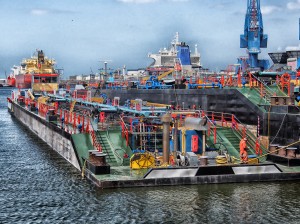 As recently as the late 1980s, the Chinese shipbuilding industry was a hodgepodge of small, government-owned shipyards building hulls with techniques and technologies that were outdated since the Second World War. As late as 1990, China built only 2.5% of the ships ordered worldwide that year, despite having 20% of the world’s population and an economy increasingly dependent on exports – and the ships that carried them. The game has changed, but China’s shipbuilders are under pressure. David Wolf looks at possible solutions.
As recently as the late 1980s, the Chinese shipbuilding industry was a hodgepodge of small, government-owned shipyards building hulls with techniques and technologies that were outdated since the Second World War. As late as 1990, China built only 2.5% of the ships ordered worldwide that year, despite having 20% of the world’s population and an economy increasingly dependent on exports – and the ships that carried them. The game has changed, but China’s shipbuilders are under pressure. David Wolf looks at possible solutions.
Over the past 20 years, Chinese shipbuilding has grown its global market share eight-fold, filling over 20 per cent of the world’s orders for oceangoing commercial vessels. It has accomplished this through consolidation, expansion, research and development, and the importation of advanced foreign shipbuilding technology.
The 10th Five-Year Plan (2001-5) made shipbuilding a “strategic industry”, and opened the door to much-needed consolidation and upgrades. Small shipyards merged into larger companies, and those firms expanded their yards to accommodate more and larger vessels. In the words of one US executive, there are now single shipyards in China with more capacity than the entire US shipbuilding industry.
The Chinese industry also invested in new technologies, with many acquiring the advanced TRIBON CAD/CAM ship design system, switching to modular construction, and offering advanced propulsion, steering and electronics. By 2008 China was poised to extend its shipbuilding prowess into advanced hull designs, placing it at technological parity with leading yards in Europe, Japan and Korea.
But the global financial crisis, following on the heels of a boom in shipbuilding spurred in part by lower prices from Chinese yards, has put such dreams on hold. After two decades of consolidation, expansion and investment, China’s shipyards are unable even to sell new bottoms to domestic shipping companies. As a result, they’re cutting prices to keep busy, and if the industry follows the accepted Chinese patterns, the result will be a beggar-thy-brother price war. Shipyards yards will continue to produce ships, even at a loss.
The yards themselves have little choice, but neither does the government. Given the strategic nature of the industry, allowing the yards to fail would be politically problematic, especially as the yards in turn support a large piece of China’s steel industry. And China’s leaders are not without a sense of history: they remember that Poland’s Solidarity movement, the labour protest that caused the Warsaw Pact to implode, began in a Gdansk shipyard. Unemployed shipwrights are a proven political force.
Thus the central government will thus likely step in to support the shipyards in the short term, working through one or more of the major “policy banks”: the Bank of China, Industrial and Commercial Bank of China, China Construction Bank and the Agricultural Bank of China.
Longer-term, writing the shipyards blank checks is unsustainable, even for Beijing. What is needed is a more permanent solution to the shipbuilding crisis, one that will be framed by two interesting issues:
First is the matter of how long the downturn will last. If this is a blip and orders start pouring in within two to three years, the near-term solution will suffice. If experience is any indication, however, it is probable that the industry faces a longer adjustment that will take years to work out excess capacity.
Even more ominous is the uncertainty around the price of oil. At what point does bunker oil become so expensive that manufacturers begin to shift production to a point closer to the customer rather than relying on supply chains that bring finished goods across oceans? For the people building or buying ships, this is more than idle speculation: it is the issue that will decide the future.
Second is at what point the Chinese Navy (PLAN) will decide that the shipyard slump offers a precious opportunity to expand the fleet at prices it may never see again. Retooling civilian shipyards to produce warships is no easy task, but the PLAN will need auxiliaries and support ships for operations far from shore, and civilian yards can produce those with relative ease.
The two of these issues come together with a relatively straightforward solution: rather than simply pour money into shipyards and pay them not to produce ships, the government could have those same yards start turning out oilers, transports, and tenders to form the logistical tail of a truly blue-water navy.
David Wolf is CEO of award-winning boutique consultancy Wolf Group Asia and author of Making The Connection. Read his blog Silicon Hutong at www.wolfgroupasia.com.


Recent Comments